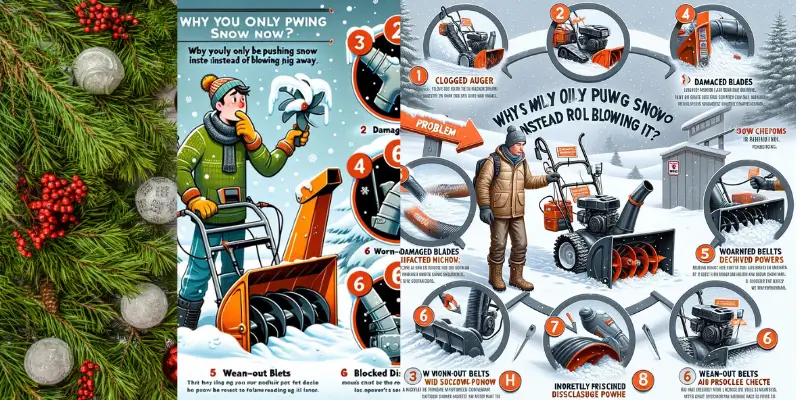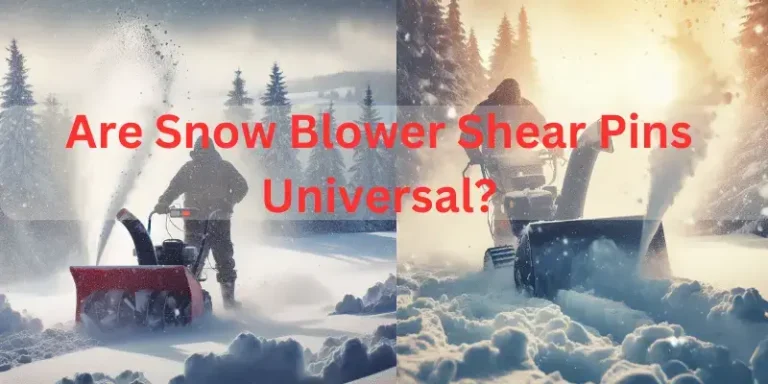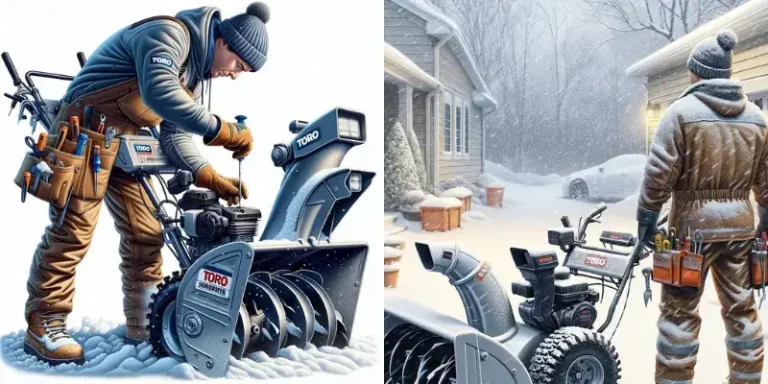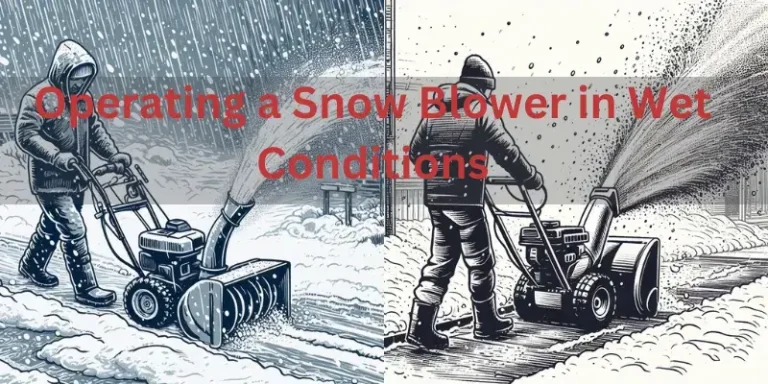6 Reasons Your Snow Blower is Pushing Snow (Troubleshooting Plus Solution)
As winter’s white blanket envelops the landscape, a snow blower becomes an indispensable ally in your battle against the snow. But what happens when your snow blower starts pushing snow instead of blowing it away?
“Understanding why your snow blower isn’t performing as expected, especially when your driveways and pathways are buried under inches of snow.“
In This blog, I am going to discuss, 6 Reasons Your Snow Blowers is Pushing Snow, then provides you with the maintenance and troubleshooting techniques to address the Snow Blower pushing issue to make your cold season comfortable by throwing away the snow from your driveways.
Understanding Your Snow Blower: Basic Mechanics and Function
Before delving into the issue, first understand how snow blower operates and works. These machines come in three main types: single-stage, two-stage, and three-stage, each type is used in different situations.
Single-stage blowers are ideal for light, fluffy snow, while two and three-stage models can handle heavy, wet snow more effectively.
Regardless of the type, the basic functionality of these three types is the same involving the auger pulling snow in and the chute being used for throwing it out. Regular maintenance is the key to keeping snowblower components functional for a long time.
“I’m going to show you a few easy steps to get your snow blower working right again. We’ll look at how to sharpen the blades and adjust the auger, and I’ll walk you through each step. Stay with me here, and by the end of this blog, you’ll know exactly what to do to fix your snow blower. Let’s turn this snow trouble into a victory”
Snow Blower is Pushing Snow: Troubleshooting/ Solutions
Reason 1: Dull or Damaged Blades
When you are troubleshooting a snowblower the first component is the Dull or Damaged Blades (Auger). These blades, or augers, are responsible for cutting the snow and inserting it into the chute. If blades or augers are not sharp or damaged, unable to pick up and throw the snow efficiently.
Signs of Dull or Damaged Blades:
- The snow blower requires more passes to clear snow.
- Snow is pushed forward rather than thrown.
Solution: Inspecting and Sharpening Blades:
- Turn off the snow blower and ensure it’s disconnected from any power source.
- Inspect the blades for any visible damage or dullness.
- If the blades are dull but undamaged, use a metal file to sharpen them, following the original angle of the edge.
- In case of significant damage, consider replacing the blades.
- Regularly checking and maintaining your snow blower’s blades will significantly improve its performance.
Reason 2: Incorrect Auger Height Adjustment
Incorrect auger height adjustment can lead to inefficient snow clearing. If the auger is set too high, it won’t be able to scoop up snow properly. Conversely, if it’s too low, it might scrape against the ground, pushing snow rather than blowing it.
Symptoms of Incorrect Auger Height:
- Incomplete snow clearing.
- Uneven snow removal patterns.
Solution: Adjusting Auger Height:
- Turn off the snow blower.
- Locate the auger height adjustment mechanism (refer to your snow blower’s manual).
- Adjust the height so that the auger is just above the ground, allowing it to pick up snow without scraping the surface.
- This simple adjustment can significantly enhance your snow blower’s effectiveness, especially in varying snow conditions.
Reason 3: Clogged Chute or Auger
A common issue with snow blowers, particularly in wet snow conditions, is a clogged chute or auger. Snow and ice can build up, preventing the snow blower from functioning correctly.
Unclogging the Chute and Auger:
- Turn off the snow blower and disconnect it from any power source.
- Use a cleaning tool (never your hands) to remove the buildup of snow and ice from the chute and auger.
Solution/ Preventive Measures:
- Regularly clean the chute and auger, especially after use.
- Apply a non-stick spray to the chute and auger at the start of the season to prevent snow from sticking.
- By keeping these components clean, you’ll ensure your snow blower runs smoothly all winter long.
Reason 4: Insufficient Engine Power
Insufficient engine power can significantly affect a snow blower’s ability to throw snow. This can be due to a variety of reasons, including issues with the fuel, spark plug, or general engine health.
Identifying Engine Performance Issues:
- The snow blower struggles to start or keep running.
- Reduced snow throwing distance.
Solution/ Troubleshooting Engine Issues:
- Check the fuel quality – stale fuel can cause engine problems.
- Inspect and replace the spark plug if necessary.
- Ensure regular engine maintenance, including oil changes and air filter checks.
- In some cases, professional servicing might be required, especially if you’re unfamiliar with engine maintenance.
Reason 5: Worn Out or Improperly Adjusted Drive Belts
Drive belts are crucial for transferring power from the engine to the auger and impeller. Over time, these belts can wear out or become loose, leading to reduced snow-blowing efficiency.
Signs of Worn Out or Improperly Adjusted Drive Belts:
- Reduced snow-throwing capacity.
- The snow blower makes unusual noises during operation.
Inspecting and Adjusting Drive Belts:
- Turn off and disconnect the snow blower.
- Access the drive belts according to the manufacturer’s instructions.
- Inspect for wear and tear and adjust the tension as needed.
- Replace the belts if they are significantly worn out.
- Regular inspection and maintenance of the drive belts are essential for keeping your snow blower in optimal condition.
Reason 6: Inadequate Machine for Snow Type/Depth
Sometimes, the issue isn’t with the snow blower itself but rather with using an inadequate machine for the specific snow type or depth. For instance, a single-stage snow blower might struggle with heavy, wet snow. It’s important to choose a snow blower that matches the typical snow conditions in your area. If you frequently face heavy snowfall, investing in a two-stage or three-stage snow blower might be necessary.
Additional Maintenance Tips for Optimal Performance
Beyond the specific issues mentioned, regular maintenance is vital for the Optimal performance of your Snowblower. These Additional Maintenance Tips are:
Using the Right Fuel and Oil
Type of Fuel
- Use fresh gasoline; avoid fuel older than 30 days.
- Opt for higher octane gasoline, as per the manufacturer’s advice
Oil Quality
- Use the oil type specified by the snow blower manufacturer.
- Change oil at the start of the season; check the level before use.
Regular Checks on Moving Parts
Auger and Impeller
- Check for wear or damage.
- Ensure they move freely without obstruction.
Drive Belt Condition
- Look for cracks or fraying.
- Check tension and adjust as needed.
Proper Storage During Off-Season
Cleaning
- Thoroughly clean to remove salt, dirt, and debris.
Storage Location
- Store in a dry, covered area to prevent rust and damage.
Fuel Treatment
- Use a fuel stabilizer or drain the fuel tank before storage.
Regular Professional Servicing
| Service Type | Servicing Guidelines |
| Annual Check-ups | Have a professional inspect and service the snow blower yearly. |
| Preventive Maintenance | Address small issues before they escalate into bigger problems. |
| Performance Optimization | Ensure optimal performance through professional calibration and adjustments. |
By adhering to these maintenance tips, you can significantly extend the life and enhance the performance of your snow blower. Regular care not only prevents common problems but also ensures your machine is ready to handle the demands of heavy snowfall, providing reliable service throughout the winter months.
FREQUENTLY ASK QUESTIONS (FAQs)
What are the common causes of a snowblower pushing snow instead of blowing it?
Common causes include broken shear pins, a malfunctioning gearbox, encountering wet or heavy snow, and the snowblower getting clogged with an object or debris.
How do shear pins affect the snowblower’s ability to function properly?
Shear pins are designed to break if the snowblower encounters an obstruction, such as a rock or thick ice, which prevents damage to the gearbox and other components.
What should I do if my snowblower stops working while pushing snow?
If your snowblower stops working, it may be due to a broken shear pin, clogged chute or auger, or a malfunctioning gearbox. Stop the machine immediately and check for these issues.
How does the type of snow, such as wet or heavy snow, impact the snowblower’s performance?
Wet or heavy snow can put additional strain on the snowblower’s engine and auger, potentially causing it to push the snow instead of effectively blowing it. This can lead to clogging and decreased efficiency.
What role do the gear and gearbox play in the snowblower’s operation?
The gear and gearbox are essential components that transmit power from the engine to the auger. Malfunctioning or broken gears can hinder the snowblower’s ability to effectively blow snow.
When should I engage the auger belt on my snowblower?
It is recommended to engage the auger belt only when ready to start clearing snow. Engaging it too early or forcefully can cause it to slip or spin, leading to potential damage.
What steps should I take if I suspect broken shear pins in my snowblower?
If you suspect broken shear pins, carefully inspect the shear pins and replace any that show signs of damage or wear. It is essential to exercise caution and upgrade to exact match replacements.
How can I prevent my snowblower from pushing snow instead of blowing it?
Proper maintenance, including lubricating components, clearing the chute’s path, and using a repellent to prevent snow buildup, can help avoid troubles with snow pushing. Additionally, being mindful of the type of snow being cleared can also help improve overall performance.
What are the indications of a malfunctioning gearbox in a snowblower?
A malfunctioning gearbox might show signs of leaks, metallic noises during operation, or a failure to engage properly. If you notice any of these symptoms, it is advisable to consult a professional for inspection and potential repair.
How can I address a snowblower pushing snow when encountering an obstacle or heavy snow?
If your snowblower is pushing snow unexpectedly, particularly when encountering an obstacle or heavy snow, it may also help to carefully uncover and remove any debris or buildup. Additionally, consider upgrading to more heavy-duty shear pins and exercise caution when operating in challenging conditions.
Conclusion
To effectively tackle the issue of a snow blower that pushes rather than blows snow, a thorough approach is necessary, starting with pinpointing the root cause, which could range from dull blades and incorrect auger height to a clogged chute, inadequate engine power, or misadjusted drive belts.
Additionally, choosing a snow blower that suits your specific snow conditions and committing to its regular maintenance is crucial. This includes using the right fuel and oil, routinely inspecting its parts, and ensuring proper storage during the off-season. These practices are not just recommendations but vital for the snow blower’s performance.
Regular professional check-ups are also key, ensuring the machine not only meets the demands of the current winter but continues to be a reliable tool for future seasons. By adopting these measures, your snow blower becomes an invaluable tool in managing winter snow efficiently.

About Naveed A Hashmi
In my childhood, I used to see my parents while working in the land, for these reasons today I have been serving the same as our own tradition and culture. I thus love to stay in it, because I want to learn something advanced and new so that I may improve my farm’s contour and help others with my experience.







